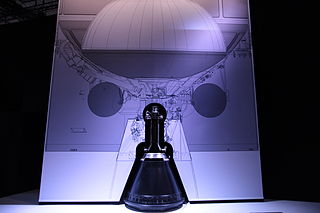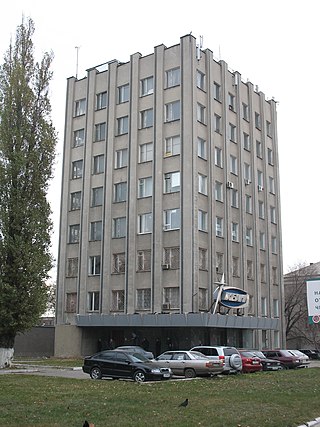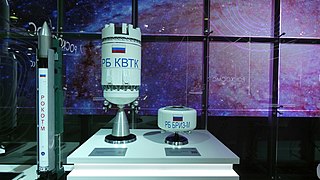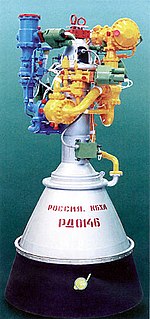
The expander cycle is a power cycle of a bipropellant rocket engine. In this cycle, the fuel is used to cool the engine's combustion chamber, picking up heat and changing phase. The now heated and gaseous fuel then powers the turbine that drives the engine's fuel and oxidizer pumps before being injected into the combustion chamber and burned.

Vega was an expendable small-lift launch vehicle operated by Arianespace, produced by Avio, and jointly developed by the Italian Space Agency (ASI) and the European Space Agency (ESA). Development began in 1998 and the first launch took place from the Guiana Space Centre on 13 February 2012. It was the 8th most launched small lift launch vehicle in history. The final flight of the rocket took place on 5 September 2024, after being replaced by the improved Vega C, already in use since 2022.

The J-2, commonly known as Rocketdyne J-2, was a liquid-fuel cryogenic rocket engine used on NASA's Saturn IB and Saturn V launch vehicles. Built in the United States by Rocketdyne, the J-2 burned cryogenic liquid hydrogen (LH2) and liquid oxygen (LOX) propellants, with each engine producing 1,033.1 kN (232,250 lbf) of thrust in vacuum. The engine's preliminary design dates back to recommendations of the 1959 Silverstein Committee. Rocketdyne won approval to develop the J-2 in June 1960 and the first flight, AS-201, occurred on 26 February 1966. The J-2 underwent several minor upgrades over its operational history to improve the engine's performance, with two major upgrade programs, the de Laval nozzle-type J-2S and aerospike-type J-2T, which were cancelled after the conclusion of the Apollo program.

The RL10 is a liquid-fuel cryogenic rocket engine built in the United States by Aerojet Rocketdyne that burns cryogenic liquid hydrogen and liquid oxygen propellants. Modern versions produce up to 110 kN (24,729 lbf) of thrust per engine in vacuum. RL10 versions were produced for the Centaur upper stage of the Atlas V and the DCSS of the Delta IV. More versions are in development or in use for the Exploration Upper Stage of the Space Launch System and the Centaur V of the Vulcan rocket.

The Angara rocket family is a family of launch vehicles being developed by the Moscow-based Khrunichev State Research and Production Space Center. The launch vehicles are to put between 3,800 kg (8,400 lb) and 24,500 kg (54,000 lb) into low Earth orbit and are intended, along with Soyuz-2 variants, to replace several existing launch vehicles.

The staged combustion cycle is a power cycle of a bipropellant rocket engine. In the staged combustion cycle, propellant flows through multiple combustion chambers, and is thus combusted in stages. The main advantage relative to other rocket engine power cycles is high fuel efficiency, measured through specific impulse, while its main disadvantage is engineering complexity.

The RD-180 is a rocket engine that was designed and built in Russia. It features a dual combustion chamber, dual-nozzle design and is fueled by a RP-1/LOX mixture. The RD-180 is derived from the RD-170 line of rocket engines, which were used in the Soviet Energia launch vehicle. The engine was developed for use on the US Atlas III and Atlas V launch vehicles and first flew in 2000. It was never used on any other rocket. The engine has flown successfully on all six Atlas III flights and on 99 Atlas V flights, with just a single non-critical failure in March 2016.

The NK-33 and its vacuum-optimized variant, the NK-43, are rocket engines developed in the late 1960s and early 1970s by the Kuznetsov Design Bureau for the Soviet space program's ill-fated N1 Moon rocket. The NK-33 is among the most powerful LOX/RP-1 powered rocket engines ever built, noted for its high specific impulse and low structural mass.

Vinci is a restartable, cryogenic, liquid-propellant rocket engine that powers the upper stage of Ariane 6. While development began in 1998 for the planned Ariane 5ME upgrade, funding for that programme shifted in 2014 to prioritize the development of Ariane 6, making Vinci the engine for the new launcher.

NPO Energomash "V. P. Glushko" is a major Russian rocket engine manufacturer. The company primarily develops and produces liquid propellant rocket engines. Energomash originates from the Soviet design bureau OKB-456, which was founded in 1946. NPO Energomash acquired its current name on May 15, 1991, in honor of its former chief designer Valentin Glushko.

Chemical Automatics Design Bureau (CADB), also KB Khimavtomatika, is a Russian design bureau founded by the NKAP in 1941 and led by Semyon Kosberg until his death in 1965. Its origin dates back to a 1940 Moscow carburetor factory, evacuated to Berdsk in 1941, and then relocated to Voronezh city in 1945, where it now operates. Originally designated OKB-296 and tasked to develop fuel equipment for aviation engines, it was redesignated OKB-154 in 1946.
The RL60 was a planned liquid-fuel cryogenic rocket engine designed in the United States by Pratt & Whitney, burning cryogenic liquid hydrogen and liquid oxygen propellants. The engine runs on an expander cycle, running the turbopumps with waste heat absorbed from the main combustion process. This high-efficiency, waste heat based combustion cycle combined with the high-performance liquid hydrogen fuel enables the engine to reach a very high specific impulse of up to 465 seconds in a vacuum. The engine was planned to be a more capable successor to the Aerojet Rocketdyne RL10, providing improved performance and efficiency while maintaining the installation envelope of the RL10.

The RD-0124 is a rocket engine burning liquid oxygen and kerosene in an oxygen-rich staged combustion cycle, developed by the Chemical Automatics Design Bureau in Voronezh. RD-0124 engines are used on the Block I stage used on Soyuz-2.1b and Soyuz-2.1v. A variant of the engine, the RD-0124A, is used on the Angara rocket family's URM-2 upper stage.
The RD-120 is a liquid upper stage rocket engine burning RG-1 and LOX in an oxidizer rich staged combustion cycle with an O/F ratio of 2.6. It is used in the second stage of the Zenit family of launch vehicles. It has a single, fixed combustion chamber and thus on the Zenit it is paired with the RD-8 vernier engine. The engine was developed from 1976 to 1985 by NPO Energomash with V.P. Radovsky leading the development. It is manufactured by, among others, Yuzhmash in Ukraine.
This page is an incomplete list of orbital rocket engine data and specifications.

The KVTK (Russian: Кислородно-Водородный Тяжёлого Класса, romanized: Kislorodno-Vodorodnyy Tyazhologo Klassa, lit. 'Oxygen-Hydrogen Heavy Class') is a liquid oxygen/hydrogen upper stage for high energy orbits that is currently under development. The KVTK contains an RD-0146D engine and is designed for use on Angara rockets. KVTK would be the first hydrogen-powered upper stage for use on a Russian launch vehicle, although Khrunichev has previously produced a hydrogen-powered upper stage (KVD-1) for the Indian Space Research Organisation's GSLV. KVTK is designed to provide up to five ignitions, allowing for complex orbital maneuvering, and have an on-orbit lifespan of up to nine hours. KVTK would allow an increase in payload to GTO of 20-50% compared to the Angara A5's standard Briz-M upper stage, powered by UDMH and N2O4.

Aestus is a hypergolic liquid rocket engine used on an upper stage of Ariane 5 family rockets for the orbital insertion. It features unique design of 132 coaxial injection elements causing swirl mixing of the MMH propellants with nitrogen tetroxide oxidizer. The pressure-fed engine allows for multiple re-ignitions.

The Soyuz-7 or Amur is a partially-reusable, methane–fueled, orbital launch vehicle currently in the design concept stage of development by the Roscosmos State Corporation in Russia. The preliminary design process began in October 2020, with operational flights planned for no earlier than 2028. Amur is intended to substitute for the existing Soyuz-2, at a much lower per launch cost.

M10 is a liquid-fuel upper-stage rocket engine in development by Avio on behalf of European Space Agency for use on Vega E. The engine, initially known as LM10-MIRA, was a derivation of the existing Russian RD-0146 engine and result of a past collaboration between Avio and Chemical Automatics Design Bureau (KBKhA) ended in 2014 after the escalation of the Russo-Ukrainian conflict and consequent economic sanctions. On May 6, 2022 engine testing campaign started at Salto di Quirra, Sardinia, with consequent maiden flight on a Vega-E launcher expected by 2026 from Guiana Space Centre.
The RD-0126 "Yastreb" was a liquid-fuel cryogenic rocket engine burning liquid hydrogen and liquid oxygen, developed by KBKhA Kosberg in Voronezh, Russia. The RD-0126 variant had a conventional de Laval nozzle, while the RD-0126E (РД-0126Э) was designed and constructed with an expansion-deflection nozzle. Both variants were designed to produce 39.2 kN (8,812.5 lbf) of thrust.

















